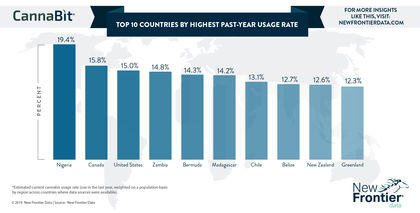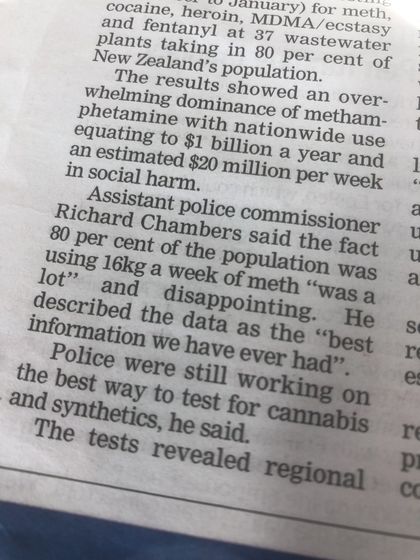The results from the first three months of national wastewater testing for for drug use were published yesterday by Police and they came with a pretty obvious headline: we're still consuming a lot of methamphetamine in New Zealand – probably even more than we were a couple of years ago.
The estimated 16kg of meth used each week dwarfs the 4kg of MDMA consumed nationwide. The "average proportion of drug use" – the release doesn't explain exactly what this measure is or how it was arrived at, but it relates to the frequency of detection in samples – was highest in Northland, with Whangarei coming in at 95%.
But Levin also came in at 95% followed by Masterton and Wanganui (94%), Central Auckland (93%) and a cluster of other centres not far behind. Meth use was lowest in Queenstown (25%), where use of cocaine and MDMA was high. (The only site that registered higher for cocaine use than Queenstown was Moa Point in Wellington, which is either people hoovering up the last of their coke before getting on a plane or some sort of Wellywood business.)
The figures for meth are inevitably shocking – but let's note right here that they don't mean meth is used by more New Zealanders than any other drug. The Police haven't published a figure that would paint a more useful picture. The main centres (Tier 1 sites) are tested for seven consecutive days each month, and pilot studies for the wastewater testing programme showed a consistent pattern: meth use remained constant across each day of the week, while MDMA, for example, showed distinct spikes at the weekends.
So meth use is habitual and MDMA use is recreational. The former is what we should really be worried about. I think it's quite possible that – bearing in mind the two-or-three-times-a-year middle class MDMA users – many more New Zealanders use MDMA annually than meth. But meth turns up in samples every day of the week, hence its high proportionality.
Also cautioning against a conclusion that everyone's on it: the per-capita figures, which suggest consumption of just over a gram a day per thousand people in Northland. (Per capita fentanyl use was also high in Northland, apparently mostly off the back of high results at the Keri Keri site. It's not really possible to know what this means: it could mean a single significant diversion of medical supplies, or just be an aberration.)
There are other things missing from the figures. When Police announced the national rollout of the programme, they said testing for cannabis would be introduced at Auckland and Northland sites. If it was, there's no sign of it in yesterday's releases. That may be because, as Massey University's Chris Wilkins explained to me in 2017, cannabis metabolites are tricky and expensive to test for – because they're fat-soluble, they tend to get stuck in solids and require a two-stage test.
Also missing: synthetic cannabinoids. They have been successfully tested for in wastewater studies elsewhere – but in this study for example, what was sought was metabolites of the JWH cannabimimetics – which are several generations back. The tests may simply not exist.
One new psychoactive substance (NPS), Alpha-PVP, was tested for, but wasn't mentioned in any of the published results. Perhaps, like heroin, none was found in samples. I'd be interested to know why Alpha-PVP was chosen for testing over other cathinones – which as a group made of 7% of substances discovered in Know Your Stuff's 2017-2018 drug-checking in the field.
Update after consulation with Know Your Stuff: As suspected, no, Alpha-PVP is not a big issue. It was found in one of 445 samples in the 2017-18 season and was one of 29 cathinones detected. They found n-ethyl pentylone far more often.
Their guess is that Alpha-PVP was the scary and newsworthy cathinone at the time the programme was set up. Things move fast in that world.
LSD – which, anecdotally, seems to have become more popular as quality and supply have improved in recent years – was also not tested for, although it's feasible, according to this comprehensive European Monitoring Centre for Drugs and Drug Addiction review.
What it comes down to is who has claim on limited resources – and, like nearly all population drug use monitoring in New Zealand, this comes out of Police budgets. This study won't give you important harm reduction-related information like the proportion of psychoactive drugs that were presumed by the user to be something else – you need Know Your Stuff talking to people for that – and it's not really meant to. At this stage, it's really laying down baselines of use for drugs prioritised by Police and it will be some time before it starts showing trends in a useful way.
I know some people dislike this form of epidemiology, but I'm all for data and this is a non-intrusive way of getting it. If it's the Police who set the parameters, I guess that's the reality unless and until some other form of funding arrives. But if I had one request, it would be that Police stop quoting the results in terms of dollar harms per the nation Drug Harm Index. The index has improved somewhat in recent years (albeit from a baseline of being basically ridiculous), and I get that budgets need to be assessed against metrics, but it's not really a meaningful thing to report.

